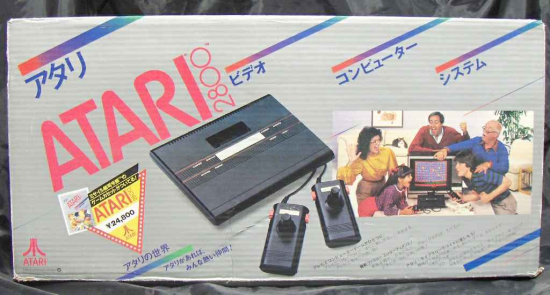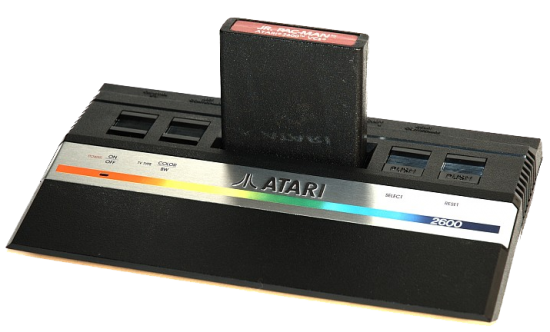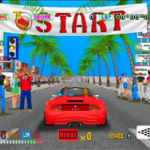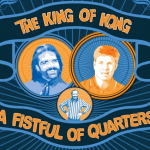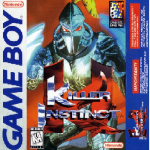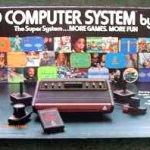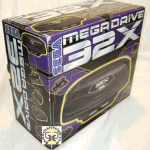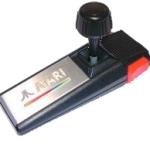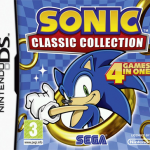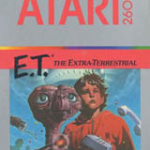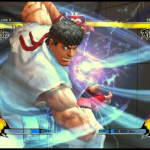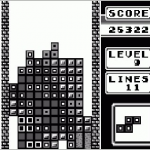Released in America in 1977, the Atari 2600 is credited as moving the video games market towards programmable cartridges rather than stand alone systems with built in games. It is regarded by many as the godfather of video games.
It was originally released as the Atari VCS (Video Computer System), which had perhaps had something to do with the release of the Fairchild VES the year before, which was the first console to use programmable ROM based cartridges. However the VCS was later rebranded as the Atari 2600 when Atari released their next console, the Atari 5200, 5 years later in 1982. The ironic thing is, the Fairchild VES was renamed the Fairchild Channel F due to the success of the Atari VCS!!
The system was released in 1977 for $199 with the game Combat. It usually came bundled with 2 joysticks and 2 paddle controllers (which were joined together via a cable) for Tennis/PONG like games. The joystick had one fire button on the left hand side.
At launch, 9 titles were available: Air-Sea Battle, Basic Math, Blackjack, Combat, Indy 500, Star Ship, Street Racer, Surround and Video Olympics. On each cartridge there was a model number under the game title, the number referring being an internal reference of the order they were developed. For example, Combat had a model number of CX2601 and a reference number of 1 and Video Olympics had a model number of CX2621 and a reference of 21.
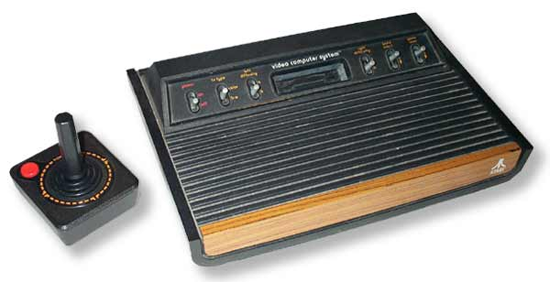
The system was very straight forward to use. On the left hand side was the on off switch, aswitch between black and white and colour and a difficulty switch for the 1st player. On the right hand side there was difficult switch for the 2nd player, a game select lever and one to reset the game. Slap bang in the middle was the cartridge slot.
The original design had a woodgrain finish at the bottom with the Atari logo at the bottom right hand side. The system, joysticks and games have become iconic. During the 80s it was common for someone to say Atari when referring to video games (i.e. I’m gonna play some Atari).
The console saw many ups and downs but all in all it was a commercial success and is fondly remembered by gamers the world over, helped in part by it’s extensive game library, which had games added to it right up until 1991!
Specifications
The Atari 2600 used the MOS Technology 6507 CPU, which was a cheaper version of their popular 6502 chip. It was clocked at 1.19 MHz. The console had 128 bytes of RAM and 4kb of ROM, which was a lot at the time. Apparently, Atari could have produced a more powerful machine but originally planned the console to have a two year lifespan, how wrong they were.
It had a native resolution of 192×160 pixels and games developers could choose from 128 colours (this was limited to 104 on PAL systems).
The Atari 2600 was quite versatile and could use input devices from other systems. For example, the Atari joystick can be used on computer systems such as the MSX and the Commodore 16.
History
Atari started working on the 2600 in 1976. It was codenamed Stella during development. PONG systems, which had been popular for a few years, had been flooded onto the market around this time. They realised that consumers would not want to replace their system every year, which is why they focused on developing a cartridge based system.
As the system was close to completion, Nolan Bushnell, the founder of Atari, had to sell the company because of lack of funds. Therefore Atari was sold for $28 million in October 1976 to Warner. (Bushell then left Atari in 1978, signing a 5 year agreement not to compete with Atari. He subsequently purchased Pizza Time Theater from Warner, which would is today better known as Chuck E. Cheese!
When the system launched, over $100 million dollars had been spent on development, an astronomical amount at the time for developing a games console. Sales were very poor at launch, no doubt partly due to the state of the video games industry at that time. The market had been flooded with dozens of PONG based systems, many of which were of a low quality. Around this time, many games developers left the market because of poor sales. This resulted in only about 250,000 Atari VCS units being sold in 1977.
However, sales slowly increased as the game library grew. Atari also developed a deal with Sears to market the console, much like they had 2 years previous with Atari Home Pong. Sears would sell the console under the name Sears Video Arcade and release games under the Tele-Games brand. Sears had stores all across the USA, which helped get the system into more homes.
In 1980 Atari released Space Invaders, a licensed version of the hugely popular Taito arcade machine. That game made over $100 million!
This helped Atari shift 2 million systems in 1980 and made them over $2 billion in profits that year alone.
The console continued to grow in popularity in the early 80s. It was around this time that the 2600 became popular in Europe. 250,000 units were sold in 1977, 550,000 units in 1978 and 2 million in 1980. However, in 1982 they sold a mind boggling 8 million Atari 2600s.
But 1982 was a very big year for Atari in the games department so it’s understandable. The long awaited port of the arcade game Pac Man deputed to poor reviews from critics but the game sold millions. 1982 was also the year that Atari finally agreed to let third party software developers to produce games in exchange for royalties. This resulted in dozens of software companies developing games for the system.
One of the largest and most influential third party companies to produce games for the Atari at this time was Activision. The company had been started in 1979 by four disgruntled ex-Atari game designers and a former music industry executive, who were unhappy with the lack of credit they were getting for games they developed. To put things into perspective, Rick Mauer, the guy who designed Space Invaders, a game which made over $100 million in profit, received a measly $11,000 for his efforts and no credit either. No wonder game designers were leaving Atari!!
 Though 1982 wasn’t a perfect year for Atari. At the end of the year they released E.T., a licensed game of the incredibly popular Spielberg film. The game cost around $125 million to develop, largely due to the licensing costs of the game. The game designer was Howard Scott Warshaw, who had received nothing but praise and adulation for his game Raiders of the Lost Ark.
Though 1982 wasn’t a perfect year for Atari. At the end of the year they released E.T., a licensed game of the incredibly popular Spielberg film. The game cost around $125 million to develop, largely due to the licensing costs of the game. The game designer was Howard Scott Warshaw, who had received nothing but praise and adulation for his game Raiders of the Lost Ark.
However, due to the amount of time that negotiations took, Warshaw was left with just 5 weeks to design the game in time for the festive period. The result: one of the worst video games ever made and one of the biggest video game commercial failures of all time. Apparently 1 million of the 5 million cartridges were sold, with rumours of the rest being buried in a New Mexico landfill.
The effects of ET and other such poor games overwhelming the market helped contribute to the video game crash of 1983, when Atari went from making Billions a year to losing over 10 thousand dollars a day.
By the mid to late 80s Nintendo and Sega began to dominate the market and helped the video games industry develop again. The Atari was still successful in Europe, South America and Japan right up until the start of the 90s, making the Atari 2600 one of the longest lasting video games consoles in history.
Variations
Atari released a few variations of the console during the 80s.
The first console, released in 1977, was quite a heavy console. It is commonly known as the CX2600 Sunnyvale, or the heavy sixer (referring to the 6 switches).
In 1978 they started shipping the CX2600. This included a channel switch on the bottom of the system but other than that, it was the same console except it was much lighter. Which is why it is sometimes referred to as the light sixer.
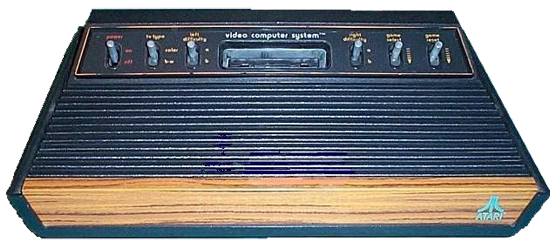
In 1980 the CX2600 was replaced by the CX2600-A. The difficulty switches for each player had been placed at the back of the console, which left 4 switches on the front of the console.
In 1982 the VCS was being rebranded as the ‘2600’ and released in all black, hence the knick name the ‘Darth Vader’. Clearly people in the 80s didn’t like wood as much as those in the 70s!
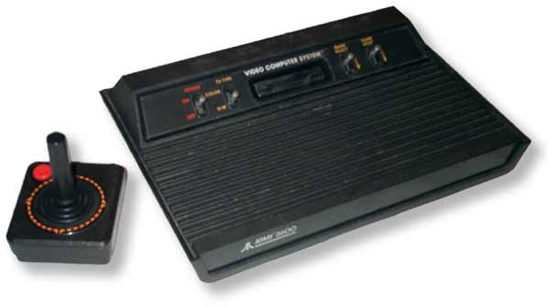
Atari entered the Japanese market in 1983 with the Atari 2800. The console had four controller ports instead of two, a different case and a different colour scheme. The controllers were different too, taking elements from both the original joystick controller and the paddle controllers.
It wasn’t a huge success in Japan though, probably due to the release of the Nintendo Famicom system a few months before.
Sears, who had previously released the Atari 2600 as Sears Video Arcade loved the design and released it in the states as Sears Video Arcade II.
In 1986 Atari released the Atari 2600 Jr. It was marketed as a budget console and was sold for under $50, boasting a games catalogue of hundreds of classic games. The design was very close to the design of the Atari 7800.
Legacy
Although the system did have a lot of poor titles, the Atari 2600 is remembered fondly by most people who grew up with the machine. Being the first console I ever owned, I would include myself in this group ?
Whilst it is nostalgic for those who played the system the first time around, the console has developed a cult following amongst a younger generation who wasn’t even alive when the 2600 was being sold. This has no doubt been helped with emulators and new versions of the console being released at dirt cheap prices. Or it could just be down to the cool logo and iconic joystick (even though the handle always bloody came off!!).
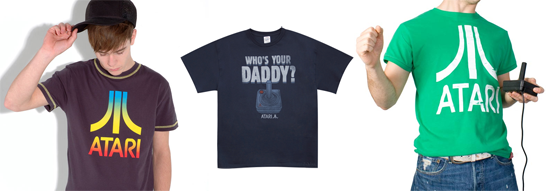
Emulation
It’s possible to play the majority of Atari 2600 games through Emulation. The two most popular programs for doing so are Stella and z26. Stella will work on Windows, Linux and Mac whereas z26 will work on Windows and Linux.
All you to do is download one of the emulators noted above and then download the game of your choice. Atari Age have an awesome collection of Atari ROMs. I recommend downloading games from there.
Videos
Atari advert from the 80s
Another Atari advertisement, this one is from 1982.
Review of the Atari 2600
Review of the Atari 2600 “Darth Vader” model

